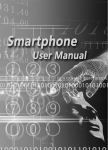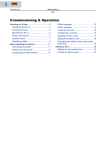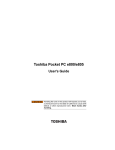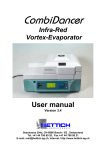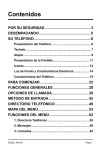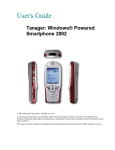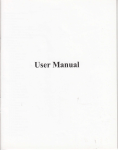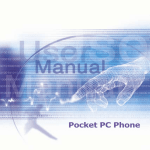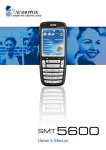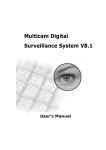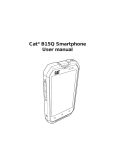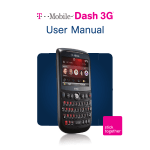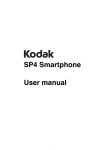Download 5.3 Receiving e-mail, MMS and SMS messages - Mobile
Transcript
5. Messaging features 78 Smartphone User Manual You must take additional steps to receive large messages and attachments, as described later in Working with large messages and attachments. 5.3 Receiving e-mail, MMS and SMS messages You can receive MMS, e-mail and SMS messages through Inbox synchronization or by connecting to your e-mail server. You can then view all of the messages in your Inbox. When you connect to the e-mail server or synchronize your Inbox with your desktop computer, only the first 0.5 KB of each new message are downloaded to Inbox on your phone by default. Only small attachments are downloaded and the original messages remain on the e-mail server or your desktop computer. When you receive an e-mail message, the Smartphone plays a sound and displays an envelope icon at the top of the screen. By default, the Home screen also displays the number of unopened e-mail and SMS messages. To quickly view new messages, select the message notification area on the Home screen. Working with the message list Received messages are stored in the Inbox folder of the appropriate account. They are displayed in the Inbox message list. 1 To view the Inbox message list: a. On the Home screen, select Start and then Inbox. b. Scroll right or left, or press Menu then Accounts, to switch to the account for which to view messages. The Inbox message list dis plays your received messages. Smartphone User Manual 79 5. Messaging features 2 To change message list display options: By default, messages are displayed in the order received. You can change the order in which messages are displayed and show the date and time that messages were sent. a. On the Home screen, select Start and then Inbox. b. Select Menu and then Options. c. Select Display. d. Change the display options and select Done. 3 To mark a message as Read or Unread: Messages that you have read are displayed in normal type with an open envelope icon. Messages that you have not read are displayed in bold type with a closed-envelope icon. You can change the status of a message by marking it as Read or Unread. a. On the Home screen, select Start and then Inbox. b. Scroll to the message to mark. d. Select Menu. e. Select Mark as Read or Mark as Unread. The message display is changed to reflect its new status: normal text for read messages and bold text for unread messages. When you synchronize or send and receive e-mail, the message is displayed as Read or Unread in all locations. Working with messages 5. Messaging features 80 Smartphone User Manual You can open messages by selecting them in the message list. Using Inbox menu commands, you can quickly reply to, forward, and delete messages. 1 To open a message: a. On the Home screen, select Start and then Inbox. b. If necessary, scroll right or left to switch to the account you want. c. Select the message to open. d. To return to the message list, press the Back key. To open the next message in the list from within an open message, scroll right; to open the previous message in the list, scroll left. To create a contact card for the sender, select Menu and then Save Sender to Contacts. 2 To specify the language for reading a message: a. From an open message, select Menu and then Options. b. In E-mail message language, scroll to the language. c. Select Done. The message is displayed using the appropriate characters for the selected language. 3 To reply to a message: a. From an open message, select Menu and then Reply or Reply All. b. Enter a message in the message area. c. Select Send. The message is stored in Outbox and sent to recipients the next time you synchronize or connect to your e-mail server. SMS messages are sent immediately. 4 To forward a message: a. From an open message, select Menu and then Forward. b. Select the account to use. c. In To, enter recipient e-mail addresses or SMS Smartphone User Manual 81 d. Optionally, you can enter an introductory message by scrolling to the message area, pressing the Action key to insert a blank line, and entering your text. e. Select Send. SMS messages are sent immediately. E-mail messages are stored in Outbox and sent to recipients the next time you synchronize or connect to your e-mail server. 5 To delete a message: a. On the Home screen, select Start and then Inbox. b. If necessary, scroll right or left to switch to the account in which to delete a message. c. Scroll to the message to delete. d. Select Menu and then Delete. For the ActiveSync account, the message is also deleted from Outlook on your desktop computer or Exchange Server the next time you synchronize. Working with large messages and attachments When you receive large e-mail messages and attachments, the Smartphone downloads only a portion of them. You can view the partial message or attachment and decide if you want to download the rest of it. When you synchronize Inbox with your desktop computer or Exchange Server, the Smartphone downloads the first 0.5 KB of each new e-mail message by default. When you connect to an Internet e-mail server, it downloads the amount (in KB) of each new message that you specified when you set up the account. The message size includes its attachments. The original messages and attachments remain on the server or your desktop computer. On messages received from a POP3 e-mail server, the attachment size is omitted. 5. Messaging features numbers. Insert a semicolon (;) between multiple addresses or SMS numbers. 5. Messaging features 82 Smartphone User Manual In the message list, messages with an attachment display an envelope icon with a paperclip. Within a message, attachments are displayed as a list of hyperlinks at the bottom of the message, and are preceded by an attachment icon. The hyperlink includes the file name and size of the attachment. The attachment icon has the following three states: • Not downloaded • Marked for download • Downloaded 1 To download a complete e-mail message: a. On the Home screen, select Start and then Inbox. b. Scroll to the message to download. c. Select Menu and then Mark for Download. The complete message is retrieved the next time you synchronize or connect to your e-mail server and send and receive e-mail. 2 To download an attachment: In an open message with an attachment to download, select the attachment. The attachment is downloaded the next time you synchronize or connect to your e-mail server and send and receive email. If there are multiple attachments in the message, all attachments are downloaded. 3 To view an attachment: In an open message containing a downloaded attachment, select the attachment. Note that you can view attachments only for file types that are supported by the Smartphone. Accepting meeting requests You can receive and respond to Outlook meeting requests on your Smartphone in a similar manner as you do in Outlook on your desktop computer: 1 On the Home screen, select Start and then Inbox. Smartphone User Manual 83 3 Select the meeting request and then respond to it as follows: a. To accept the meeting request and insert the meeting into your calendar, select Menu and then Accept. b. To decline the meeting request, select Menu and then Decline. c. To tentatively accept the meeting request and insert a tentative meeting into your calendar, select Menu and then Tentative. Your response is sent back to the meeting organizer the next time that you synchronize. For more information about synchronizing, see Chapter 7 Synchronizing information. 5.4 Viewing your message folders Each messaging account has a set of folders in which the Smartphone stores messages for that account. The default folders are: • Deleted Items contains messages that you delete until you empty this folder. • Drafts contains messages that you save before sending. • Inbox contains messages that you receive. • Outbox for the ActiveSync account, contains sent e-mail messages until you synchronize. For e-mail accounts, contains sent e-mail messages until you connect to your e-mail server. SMS messages are sent immediately over the network and appear in your SMS Outbox folder only for 5. Messaging features 2 If necessary, scroll right or left to switch to the ActiveSync account. 5. Messaging features 84 Smartphone User Manual a few seconds. • Sent Items contains copies of messages that you send. If you want, you can move a message to a different folder within the same account. When you synchronize or send and receive e-mail, the Smartphone synchronizes any additional e-mail folders that you have created in Outlook on your desktop computer or on your e-mail server. It also synchronizes the messages contained in those folders, if the folders are marked for synchronization. Viewing message folder contents 1 On the Home screen, select Start and then Inbox. 2 Select Menu and then Accounts/Folders. 3 Scroll to the account for which to view the contents of a message folder. 4 Select Folders and then the folder to view. To view all ActiveSync folders, even those not marked to synchronize, select Menu and then Show All Folders. 5 To return to Inbox, press Back, select Menu and then Accounts/Folders. Smartphone User Manual 85 7 Select Folders and then Inbox. Marking a folder for synchronization 1 You may synchronize Inbox with your desktop computer. This creates the same ActiveSync Inbox folders on your Smartphone as in Outlook on your desktop computer. 2 On the Home screen, select Start and then Inbox. 3 Select Menu and then Accounts/Folders. 4 Scroll to ActiveSync and then select Folders. 5 Select Menu and then Manage Folders. 6 Scroll to a folder to synchronize. 7 Select Show and then Done. The next time you syn chro nize, the folder(s) that you marked on your Smartphone are synchronized with the corresponding folders in Outlook on your desktop computer. Moving a message to a different folder 1 On the Home screen, select Start and then Inbox. 2 If necessary, scroll right or left to switch to the account in which to move a message. 3 Scroll to the message to move. 5. Messaging features 6 Scroll to the account. 5. Messaging features 86 Smartphone User Manual 4 Select Menu and then Move. 5 Select the folder into which to move the message. You can move an open message in the same manner, by selecting Menu and then Move. Emptying the Deleted Items folder 1 On the Home screen, select Start and then Inbox. 2 Select Menu and then Accounts/Folders. 3 If necessary, scroll right or left to switch to the account for which to empty the Deleted Items folder. 4 Select Folders and then Deleted Items. 5 Select Menu and then Empty Folder. 5.5 Managing your Inbox All MMS, e-mail and SMS messages are stored in your Inbox. By default, the most recently received messages are displayed at the top of the Inbox list. Using the menu options, you can customize your Inbox settings to control the way you send, receive, and view messages. Smartphone User Manual 87 5. Messaging features Using Inbox menu options It is easy to accomplish common messaging tasks from your Inbox. Press the New soft key to compose a new message, or press the Menu soft key to forward, delete, and reply to messages, access Inbox options you can customize, and more. To view Inbox menu options: On the Home screen, press the Start soft key, select Inbox, and then press the Menu soft key. 5. Messaging features 88 Smartphone User Manual The following table lists Inbox menu options and their functions. Inbox menu option Function Delete Deletes the selected message. Reply Replies to an open or selected message. Reply All Replies to the sender and those who received a copy of the open or selected message Forward Forwards the selected m Move Enables you to move the open or selected message to another folder Mark as Unread Displays the header text of a message in your Inbox in bold, indicating that the message has not been read. Mark as Read Displays the header text of a message in your Inbox in lightface, indicating that the message has been read Mark for Download Retrieves the entire e-mail message from the e-mail server the next time you connect. Options Displays a list of Inbox options that you can customize (see the following table). Send/Receive Connects to your e-mail server to send and receive messages. Accounts/ Folders Displays all message folders. Smartphone User Manual 89 You can optimize your Inbox for the way you work. For example, you can change the way your messages are displayed, specify how you want your messages to be sorted, specify the volume and limit the size of messages you want to automatically download, change your synchronization schedule, and more. 1 On the Home screen, press the Start soft key and then select Inbox. 2 Press the Menu soft key, and then select Options. 3 Select the option to customize. 4 Modify the settings to change, and press Done. The following table lists the Inbox options and their functions. Inbox menu option Function Display Enables you to change the message information displayed in your inbox. Sending Enables you to specify whether you want to include an original copy of the message in your reply, save a copy of your sent message, or use Unicode for SMS messages. Editing My Text Enables you to edit the predefined text that you can insert in messages. Signatures Enables you to add a signature in messages. Account Setup Enables you to set up your accounts. Import SIM Messages Enables you to import SMS messages from a SIM card to your inbox. The messages are not removed from the SIM card after they are imported. 5. Messaging features Customizing Inbox options 5. Messaging features 90 Smartphone User Manual 5.6 Instant messaging You can use MSN Messenger on your Smartphone to send and receive instant messages. MSN Messenger on your Smartphone provides the same chat environment as MSN Messenger on your desktop computer. Features of this environment include: • Sending and receiving instant messages. • Seeing the status of others in your Messenger contacts list, or changing your own status (e.g., available, busy, out to lunch). • Inviting other people to a chat conversation. • Blocking contacts from seeing your status or sending you messages. Setting up MSN Messenger Before you can use MSN Messenger, you must take steps to set it up. First, you need either a Microsoft .NET Passport account or a Hotmail account. To set up a Microsoft .NET Passport account, go to: http://www.passport.com. Once you have this account, you need to do the following: Create a connection on your Smartphone, such as a modem or wireless connection that allows you to connect to the Internet. For more information about creating connections, see 3.3 Data connections. Using MSN Messenger You can sign in to MSN Messenger using your Hotmail credentials or your .NET Passport: 1 To sign in to and sign out of MSN Messenger: a. On the Home screen, select Start. b. Select MSN Messenger. Smartphone User Manual 91 d. In Sign-in Name, enter the sign-in name that you use for Hotmail or your .NET Passport (Example: [email protected]). e. In Password, enter your Hotmail or .NET Passport password. f. Select Remember my password if you don't want to enter your password again in the future. g. Select Sign In. h. To sign out, press the Menu soft key and select Sign out. If you do not sign out of MSN Messenger, you will remain on a data connection. This may result in additional charges from your service provider. 2 To add an MSN Messenger contact: a. In the MSN Messenger contacts list, select Menu and then Add Contact. b. Add the Hotmail or .NET Passport sign-in name of a person with whom you want to chat. Their sign-in name is added to the contacts list. 5. Messaging features c. Select Sign In. Smartphone User Manual 5. Messaging features 92 3 To delete an MSN Messenger contact: a. In the MSN Messenger contacts list, select the contact. b. Select Menu and then Delete Contact. 4 To send an instant message: a. Sign in to MSN Messenger. b. Scroll to the contact with whom you want to chat. c. Select Menu and then Send Message. d. Enter your message and select Send. This starts a chat with the contact. To quickly add common messages, select Menu, select My Text, and then select the text to use. To edit this text, select Menu, select Options, and then select Edit My Text. Select the text, make any edits, and then select Done. 5 To reply to an instant message: a. Select Menu and then Chats. b. Select the name of the person sending the instant message. The message displays, along with a box for your reply. c. Enter your reply and select Send. If you want to be able to receive instant messages at any Smartphone User Manual 93 6 To invite a contact to an ongoing chat: From a chat, select Menu, select Invite, and then select a contact. The contact receives an instant message and can join the chat. 7 To change between chats: a. Select Menu and then Chats. b. In the list of ongoing chats, select the name of a contact with whom to chat. 8 To return to the contacts list: From a chat, select Menu and then My Contacts. 9 To end a chat: Select Menu and then End Chat. 10 To see who is already chatting: Select Menu and then Chats. 11 To block or unblock an MSN Messenger contact: a. In the MSN Messenger contacts list, select the contact's name. b. Select Menu and then Block. The contact will no longer be able to see your status or send you messages. c. To unblock the contact, select Menu and then Unblock. 12 To change your status: a. In the MSN Messenger contacts list, select your name. b. Select a status description, such as Away. This status is displayed next to your name in the contact lists of your contacts. 5. Messaging features time your Smartphone is connected to a network, select Menu and then Options. Select Passport Account, select Run this program when connection is available, and then select Done. 5. Messaging features 94 Smartphone User Manual 13 To change your display name: a. In the MSN Messenger contacts list, select Menu. b. Select Options and then Passport Account. c. In My display name, enter your name as you want it to display in the contacts lists of your contacts. Chapter 6 Contacts, Calendar, and Tasks 6.1 Using Contacts 6.2 Using Calendar 6.3 Using Tasks 6.4 Using Photo Contacts 96 Smartphone User Manual 6. Contacts & Calendar 6.1 Using Contacts You can think of Contacts as an online address book, where you can store information about people and businesses you communicate with in contact cards. For example, you can store multiple phone numbers, e-mail and street addresses, Web pages, birthday, anniversary date, etc. You can use Contacts to dial phone numbers and compose e-mail and SMS messages directly from a contact card. The Contact list The Contacts list displays the names of your contacts alphabetically, along with an abbreviation for the default communication method, such as the person's work phone number (w) or home phone number (h). This makes it easy to reach the contact using the method you prefer. If the contact card includes a work phone number, your phone will automatically set it as the default number. 1 To access Contacts: On the Home screen, press the Contacts soft key. Smartphone User Manual 97 The following table shows possible abbreviations that might be displayed in the Contacts list and their meanings. Abbreviation Meaning w Work phone w2 Second work phone Home phone h2 Second home phone m Mobile phone pgr Pager car Car phone sms SMS address e E-mail address e2 Second e-mail address e3 Third e-mail address web Web page 2 To call a contact using the default number: a. On the Home screen, select Contacts. b. Select the contact to call. c. Press the Talk button. The Smartphone dials the contact's default phone number. The abbreviation for this number appears to the right of the contact name. If you have a long list of contacts and you don't see the contact you want to call on the first screen, enter the first few letters of the contact's name; the phone will search through the entire Contacts list and display the name. 6. Contacts & Calendar h 98 Smartphone User Manual 3 To call a contact using a number other than the default number: a. On the Home screen, select Contacts. 6. Contacts & Calendar b. Select the contact, scroll right or left to display the abbreviation for the number you want to use, and then press the Talk button. 4 To find a contact by entering a name: a. On the Home screen, select Contacts. b. Begin entering the name of the contact to find until the name is displayed. For example, to find "Sandra," enter 7, 2, 6, 3, 7, 2 because these numbers correspond to the letters for that name. 5 To filter contacts: a. On the Home screen, select Contacts. b. Select Menu and then Filter. c. Select a category to filter, such as Business, Miscellaneous, or Personal. The contacts assigned to the category you select are displayed in the list. 6 To create a new contact: a. On the Home screen, press the Contacts soft key, and press the New soft key. b. Enter information for the new contact. c. Select Done. 7 To delete a contact: a. On the Home screen, press the Contacts soft key. b. Select the contact to delete, press the Menu soft key, select Delete, and then select Yes to confirm. Contact cards A contact card displays all of the information that you have entered for the contact, such as name of the person or business, phone numbers, e-mail addresses, and more. From a contact card, just select a phone number and press the Talk button to call the number. You can also select an e-mail address and press the Action button to begin composing a message to the contact. Smartphone User Manual 99 1 To view and edit a contact card: a. On the Home screen, select Contacts. b. Select the contact whose card you want to view. c. To edit the card, select Edit. d. When finished making changes, select Done. 6. Contacts & Calendar 2 To call a contact from a contact card: a. On the Home screen, select Contacts. b. Select the contact, and press the Action button to open the contact card. c. Select the number to use, and press the Talk button. 3 To send an e-mail from a contact card: a. On the Home screen, select Contacts. b. Select the contact, and press the Action button to open the contact card. c. Select the e-mail address, and press the Action button. d. Select an account to use, and press the Action button. e. Enter a subject, compose your message, and then select Send. SIM contact SIM contacts are stored on your SIM card. When you insert your SIM card into a different device, you can view and 100 Smartphone User Manual use the SIM contact information on the new device. Unlike regular contact cards, you can store only 1 phone number for each SIM contact. To create a new SIM contact: 6. Contacts & Calendar 1 On the Home screen, select Contacts and then Menu. 2 Select New SIM Contact. 3 Enter the contact's name and phone number. 4 Select Done. The new contact appears in your contact list. A SIM icon appears to the right of the name, indicating that the contact is stored on your SIM card. Using contact card menu options Using the contact card menu options, you can quickly apply a speed dial to the contact, beam the contact card to another mobile device or a desktop PC using infrared, etc. To view contact card menu options: On the Home screen, select Contacts and then Menu. The following table lists the contact card menu options and their functions. Smartphone User Manual 101 Menu Options Function Enables you to create a shortcut to a phone number, e-mail address, or Web URL by assigning one or two numbers as a speed dial. Add Voice Tag Enables you to create a shortcut to a phone number, e-mail addres, or Web URL by assigning one or two numbers as a recording. Set as Default Makes the selected phone number or e-mail address the default communication methode for the contact. Beam Contact Sends the contact card to another mobile device or a desktop PC using infrared. Delete Removes the contact card from the Contacts list Edit Enables you to modify information in the contact card. 6.2 Using Calendar Calendar is the scheduling program on your Smartphone, where you can create and view appointments and view your calendar by day, week, or month. When you create and edit appointments in Calendar, your changes are reflected in Outlook on your desktop computer when you synchronize. 1 To open Calendar: On the Home screen, select Start and then Calendar. 2 To create a new appointment: a. On the Home screen, select the Start soft key. b. Select Calendar. c. Select Menu and then New. d. Enter information about the appointment. e. In Reminder, scroll to the amount of time before the 6. Contacts & Calendar Add Speed Dial 102 Smartphone User Manual 6. Contacts & Calendar appointment that you want to be reminded. If you don't want to be reminded, select None. When you create a new appointment on your Smartphone, you can synchronize Calendar with your desktop computer or Exchange Server to keep your schedule information upto-date in all locations. The default reminder time is 15 minutes prior to an appointment. You can change this by selecting Menu and then Options from within Calendar. 3 To edit an appointment: a. On the Home screen, select Start. b. Select Calendar. c. Select the appointment, press the Action button and then select Edit. d. If the appointment is recurring, select Yes to edit only the current occurrence, or select No to edit the series. e. Make your changes and select Done. 4 To delete an appointment: a. On the Home screen, select Start and then Calendar. b. Scroll to the appointment to delete. c. Select Menu and then Delete. Smartphone User Manual 103 d. If the appointment is recurring, select Yes to delete only the current occurrence, or select No to delete the series. Viewing your schedule 1 Agenda view: Agenda view is the default view for calendar information. This view displays meetings and appointments scheduled for the current day. Appointments are shown in chronological order according to start time. All-day appointments are shown as a single line at the top of the Agenda view. a. To view today's agenda: You may select your upcoming appointments on the Home screen, or you may select Menu from Week or Month view in Calendar, and then Go to Today. To view previous or approaching dates, scroll left or right. b. To view your agenda for a specific date: On the Home screen, select Start. Select Calendar. Select Menu and then Go to Date. Enter the date to view and select Done. 2 Week view: Week view shows your schedule a week at a time. Week view gives you a quick indication of your free 6. Contacts & Calendar You can view your schedule in three different views: Agenda, Week, and Month. 104 Smartphone User Manual and busy time, and allows you to create an appointment at a selected time easily. 6. Contacts & Calendar By default, Week view displays the hours from 9:00 A.M. to 5:00 P.M. in one-hour increments on the left side of the screen. You can scroll up or down to show the hours before or after those displayed. To view appointments for the week: On the Home screen, select Start. Select Calendar. Select Menu and then Week View. 3 Month view: Month view provides an overview of your schedule one month at a time. Arrows pointing upward represent morning appointments, and arrows pointing downward represent afternoon appointments. If you have both morning and afternoon appointments on the same day, the arrows form a colored box. All-day events are indicated by an empty box. If you have morning and afternoon appointments and an all-day event on the same day, an empty box surrounds a colored box. To view appointments for the week: On the Home screen, select Start. Select Calendar. Select Menu and then Month View. Customizing the calendar view You can change viewing options for Calendar, such as specifying the first day of the week and the number of days per week to display, as well as showing and hiding week numbers. 1 On the Home screen, select Start. 2 Select Calendar. 3 Select Menu and then Options. Smartphone User Manual 105 4 Scroll to select the options you want and select Done. Importing calendar information 6.3 Using Tasks A task is a personal or work-related project, assignment, or errand to track through completion. A task can occur once, or it can recur. A recurring task can repeat at regular intervals or repeat based on the date you mark the task complete. For example, you might want to pay a bill on the last Friday of every month, or get a haircut when one month has passed since your last haircut. The task list The task list is your "things to do" list. When you create or edit tasks with Outlook on your desktop computer and then synchronize with your Smartphone, additional task information may display. A task that has been marked as high priority is preceded by an exclamation mark, and one marked as low priority by a down arrow. On color devices, overdue tasks are displayed bold and red. If you synchronize tasks with your desktop computer, completed tasks are removed from your Smartphone during synchronization. They are then displayed in gray with a strikethrough on your desktop computer. 6. Contacts & Calendar You can import calendar information from another calendar program that uses the iCal or vCal format. You can import calendar information from attachments in e-mail messages, SMS messages, and links in Microsoft(R) Pocket Internet Explorer, or by beaming. When you import information and then synchronize, the information is added to Outlook on your desktop computer. 106 Smartphone User Manual 1 To create a new task: On the Home screen, select Start, More and then Calendar. Enter the task and press the Action key. 6. Contacts & Calendar 2 To mark a task as Complete: On the Home screen, select Start, More and then Calendar. Scroll to the task and select Complete. 3 To change a completed task to incomplete: On the Home screen, select Start, More and then Calendar. Scroll to the task and select Activate. 4 To delete a task from the task list: On the Home screen, select Start, More and then Calendar. Scroll to the task and select Delete. Using voice notes You can use Voice Notes to work with short voice recordings, or voice notes. Voice notes are included in the All Notes list and are named consecutively (Recording 1, Recording 2, and so on). 1 To create a voice note: a. Hold the Smartphone microphone near your mouth. b. Press the Record button, select the Record soft key, and speak your voice note. c. Select Stop to stop recording a voice note. The voice note is recorded and appears in the All Notes list of Voice Notes. To listen to a recording, select it in the All Notes list, select Menu, and then select Play. 2 To rename a voice note: a. On the Home screen, select Start. b. Select More and then Voice Notes. Smartphone User Manual 107 c. Scroll to the voice note to rename. d. Select Menu and then Rename. e. In Name, enter a new name. f. Select Done. 3 To delete a voice note: b. Select More and then Voice Notes. c. Scroll to the voice note to delete. d. Select Menu and then Delete. e. Select Yes. If you delete a voice note that has a default name, such as Voice Note 1, this name becomes available for a new voice note that you create. For example, if you have three voice notes, named Voice Note 1, Voice Note 2, and Voice Note 3, and you delete Voice Note 1, the next voice note you create will be named Voice Note 1. Beaming information You can use the Bluetooth or infrared port on your Smartphone to send and receive (beam) calendar appointments and contact cards between your Smartphone and another mobile device or a desktop computer that has Bluetooth or an infrared port and supports vCards and vCal. Alternatively. However, you can not beam SIM contacts. 1 To beam a contact: a. On the Home screen, select Contacts. b. Select the contact to beam. c. Select Menu and then Beam Contact. d. Scroll to the device to which you want to beam. e. To beam by infrared, make sure that the infrared ports are unobstructed and within close range of each other. f. To beam by using Bluetooth, make sure that both 6. Contacts & Calendar a. On the Home screen, select Start. 108 Smartphone User Manual Bluetooth radios are turned on and that Bluetooth is discoverable on the receiving device. 6. Contacts & Calendar g. Select Beam. Status information will then be displayed, indicating the name of the device to which the Smartphone is beaming, and whether the beaming process is pending, finished, or has failed. 2 To beam an appointment: a. On the Home screen, select Start. b. Select Calendar. c. Select the appointment to beam. d. Select Menu and then Beam Appointment. e. Scroll to the device you want to beam to. f. To beam by infrared, make sure that the infrared ports are unobstructed and within close range of each other. g. To beam by using Bluetooth, make sure that both Bluetooth radios are turned on and that Bluetooth is discoverable on the receiving device. h. Select Beam. Status information displays, indicating the name of the device to which the Smartphone is beaming, and whether the beaming process is pending, finished, or has failed. 3 To receive beamed information: Smartphone User Manual 109 a. On the Home screen, select Start. b. Select Settings and then Beam. c. Select Receive incoming beams. d. To receive by infrared, align the infrared ports so that they are unobstructed and within close range of each other. f. Select Yes to receive the information. Once you select Receive incoming beams, your device automatically receives beams until you clear this check box. Your Smartphone can receive beamed files of any type, but you may need to copy some files to your desktop computer for viewing. 3.6 Photo Contacts Photo Contacts makes using your Pocket PC more fun and practical than ever before. It allows you to assign still or animated photos to the entries in your Contacts. Then when a person calls you (for whom you have previously assigned a photo ID in Contacts), that photo ID will appear on your Pocket PC’s incoming call screen. Use the rich set of features to get the photos displayed with the size, position, and animated ID template you want. To activate Photo Contacts: Press Start, More, then Photo Contacts. Photo Contacts do not run automatically when you turn on your phone. You must turn them on. To Check if Photo Contacts are loaded: 6. Contacts & Calendar e. To receive by using Bluetooth, make sure your Bluetooth radio is turned on and in discoverable mode. 110 Smartphone User Manual After you open Photo Contacts they will start to load. If you see in the top toolbar, it indicates photo 6. Contacts & Calendar contacts are loaded. indicates that they are not loaded yet and therefore an incoming call will not show the picture. To create a new photo contact: 1. Press Start, More, then Photo Contacts. 2. Select a contact from the list, or create a new one by pressing Menu then New. Contacts here fully mirror those in Microsoft Contacts. 3. Press Assign Photo. 4. Select a picture file, then press Next (to look in different folder for a picture press Menu then Change Folder) and Done. To customize and adjust settings for a contact: Select a picture, press Next - as described above - then press Menu. In this Menu you can: a. Change the assigned template by pressing Next Template or Previous Template. b. Change to photo only - no template - by pressing Display Settings, then Use photo only. A few sample Photo Contacts templates (animated graphical templates that can frame your assigned photos) are included in your Smartphone’s local storage in the \My Smartphone User Manual 111 Documents\Templates folder. For more templates go to IA Style website http://www.iastyle.com 6. Contacts & Calendar c. Choose how you want the photo to fit to the window. d. Enlarge the photo if it is smaller than the window. e. If you disable the template option, then you can choose a size and position for the picture by pressing Change position. f. If you choose Photo only, then you can decide its size by pressing Display Settings, Size, then choosing a pixel size from the list. g. Choose to assign a different photo. To assign a photo from the camera: 1. Press Start, More, then Photo Contacts. 2. Select a contact from the list, or create a new one. 3. Press Assign Photo, Menu then New from Camera. 4. After you take the picture, customize if necessary, then press Done. To unassign a photo: 1. Press Start, More, then Photo Contacts. 2. Select a contact from the list, and open it. 3. Press Menu, then Unassign Photo. 6. Contacts & Calendar 112 Smartphone User Manual To filter photos: 1. Press Start, More, then Photo Contacts. 2. Press Menu, Filter, then select from No Filter, Contacts only, SIM only and Group. To change from Landscape to Portrait: 1. Press Start, More, then Photo Contacts. 2. Select a contact from the list, and press Assign Photo. 3. Press Menu, then select to display thumbnails as Landscape or Portrait. Managing your groups You can create a new group, rename, delete, and assign and unassign members and photos to a group To assign a contact to a group: 1. Press Start, More, then Photo Contacts. 2. Press Menu, then Manage Group. 3. Select a group from the list, or press Menu to create a new group. 4. Press Menu again to Assign Members, Rename, Delete or Assign Photo. Smartphone User Manual 113 The Set Default Photos screen lets you assign, unassign, and preview default Photo IDs to appear for these three situations: Unknown photo This photo will display whenever the phone number of the incoming call is not known to Caller ID because no phone number was “passed in” to your Pocket PC. This would occur if the person calling you has blocked their phone number from being displayed to the receiver, or has not enabled the broadcast of their Caller ID. Not-found photo This option in the Set Default Photos screen lets you assign a generic Photo ID to any incoming call from a person whose number is not found in your Contacts. That is, the phone number of the incoming call is known, but has no matching entry in your Contacts. Default photo This photo will display when the incoming call is found to be from a matching entry in your Contacts database, but so far there is no individually-assigned Photo ID for either that individual Contact entry, or for the Group it belongs to. To set Default Photos: 1. Press Menu, Options then Set Default Photos. 2. Select Unknown photo, Not-found photo or Default photo. 6. Contacts & Calendar Set Default Photos 114 Smartphone User Manual 6. Contacts & Calendar 3. Select a picture, then assign settings. Chapter 7 Synchronizing information 7.1 Understanding ActiveSync 7.2 Synchronizing with a desktop computer 7.3 Synchronizing with a server 7.4 Other synchronization information 116 Smartphone User Manual 7.1 Understanding ActiveSync ActiveSync synchronizes information stored on your Smartphone with Microsoft Outlook information on your desktop computer or Microsoft Exchange Server. It also allows you to share files between your phone and your desktop computer. 7. Synchronizing When you synchronize, ActiveSync compares the information on your device with the information on your desktop computer and/or Exchange Server and updates all locations with the most recent information. With ActiveSync, you can: • Synchronize Inbox, Contacts, Calendar, and Tasks information on your phone with your desktop computer. • Synchronize Inbox, Contacts, and Calendar on your phone with the Outlook information on a server running Microsoft Exchange Server so that you have the latest information, even when your desktop computer is turned off. • Copy (rather than synchronize) files between your phone and your desktop computer. • Synchronize on a schedule to control when synchronization occurs. • Select which types of information are synchronized and specify how much information is synchronized. For example, you can choose how many weeks of past appointments to synchronize. Using Server ActiveSync, you can synchronize information directly with a Microsoft Exchange Server if your company is running Microsoft Mobile Information Server. Smartphone User Manual 117 7.2 Synchronizing with a desktop computer Installing ActiveSync Before you can synchronize information with a desktop computer, you must first install ActiveSync on your desktop computer and create a partnership between your Smartphone and your desktop computer. Creating a partnership As soon as ActiveSync installation completes, the New Partnership wizard helps you set up a partnership between your Smartphone and your desktop computer. When you finish using the wizard, the first synchronization begins automatically. When synchronization completes, you will notice that the information from your desktop computer that you selected now appears on your Smartphone. Before you begin setting up ActiveSync, you should get the information you will need and connect the device to your computer by a serial, USB, or infrared connection. 7. Synchronizing You can install ActiveSync on the desktop computer from the Smartphone Companion CD. ActiveSync is already installed on your Smartphone. 118 Smartphone User Manual To prevent synchronization problems, select Synchronize with Microsoft Mobile Information Server and/or this desktop computer in the New Partnership wizard only if you are certain that your company is running Microsoft Mobile Information Server 2002 or later and you know the server name. Otherwise, select Synchronize with this desktop computer. For more information, contact your network administrator or service provider. 7. Synchronizing Starting and stopping synchronization The first synchronization begins automatically after you finish using the New Partnership wizard. From then on, you may start and stop the synchronization in the following way: 1 On the Home screen, select Start and then ActiveSync. 2 To start synchronization, select Sync. 3 To stop synchronizing, select Stop. Deciding which information to synchronize By default, ActiveSync does not automatically synchronize all types of Outlook information. You can use ActiveSync options to turn synchronization for specific information types on and off: 1 On your desktop computer, open the Microsoft ActiveSync program. Click on Options. 2 By default, Calendar, Contacts, Tasks, and Inbox are synchronized. Clear the check box for the item you do not want to synchronize. Smartphone User Manual 119 3 To adjust the settings for a particular type of information, click on the type and then select Settings. For example, you may select which folders in Inbox to synchronize. 7. Synchronizing 7.3 Synchronizing with a server You can use the New Partnership wizard when you are first setting up a partnership with a desktop computer to synchronize with an Exchange server. In the New Partnership wizard, select Synchronize with Microsoft Mobile Information Server and/or this desktop computer, instead of Synchronize with this desktop computer. If at some later time you want to synchronize with a server when the device is connected to the desktop computer, you must then configure ActiveSync on the desktop computer as described in "Synchronize with a server" in ActiveSync Help on the desktop computer. 120 Smartphone User Manual 1 To configure an Exchange Server connection: a. If the device is connected to your desktop computer, disconnect it. On the Smartphone Home screen, select Start. b. Select ActiveSync. c. Select Menu and then Options. d. Select Server Settings. e. Select Connection. f. In User name, enter your Microsoft Exchange user name. 7. Synchronizing g. In Password, enter your Microsoft Exchange password. h. In Domain, enter the name of the domain of your Exchange server (if required). i. If you want the device to save your password so that you need not enter it when connecting, select Save password. j. If configuring a Server Name, enter name of your Exchange server. k. Select Done. 2 To change Exchange server synchronization settings: a. Before you change synchronization settings, disconnect the device from your desktop computer. On the Smartphone Home screen, select Start. b. Select ActiveSync. c. Select Menu and then Options. d. Select Server Settings. e. Select the synchronization settings to edit: Calendar, Contacts, or Inbox. To start synchronizing Calendar, Contacts, or Inbox information, select Sync [Information Type] with a server on the appropriate synchronization settings page. To stop synchronizing Calendar, Contacts, or Inbox information, clear the Sync [Information Type] with a server check box on the appropriate synchronization settings page. Smartphone User Manual 121 Change the amount of information to be synchronized. Creating a synchronization schedule You can create a schedule for automatically synchronizing information on your Smartphone with your desktop computer or with Microsoft Exchange Server. To set up a synchronization schedule with your desktop computer, you must use ActiveSync on the desktop computer. For instructions, see Change desktop synchronization schedule in ActiveSync Help on the desktop computer. • Peak times schedule: To synchronize during working hours or other times you experience higher mail volumes. • Off-peak schedule: To synchronize during times when you experience lower mail volumes. When you are roaming, you can synchronize manually to reduce roaming charges, or you can synchronize using the mobile schedules. 1 To edit schedule settings, your Smartphone must be disconnected from your desktop computer. On the Smartphone Home screen, select Start. 2 Select ActiveSync. 3 Select Menu and then Options. 4 Select Mobile Schedule. a. Select how often to synchronize in the Peak time sync list. b. Select how often to synchronize in the Off-peak time sync list. c. Select whether or not to synchronize on a schedule in the Roaming sync list. d. Select Sync outgoing items as they are sent to synchronize every time you send e-mail. 5 Select Done. 7. Synchronizing To set up a synchronization schedule with Exchange server, you must use ActiveSync on your Smartphone. You can schedule synchronization of your device on two separate schedules: 122 Smartphone User Manual If you create a schedule for synchronizing while connected to a desktop computer as well as a schedule for synchronizing remotely (wirelessly), the Smartphone synchronizes according to both schedules. 7. Synchronizing Synchronizing Automatically With ActiveSync you can schedule automatic synchronization between your device and a server every time an item arrives or is changed at the server. Your device is informed of that event and synchronizes automatically to retrieve those items, making your device always up-to-date. You must synchronize your device at least once (such as after creating a partnership) before you can see and change the settings for synchronization as items arrive. You can synchronize as items arrive only if your company or service provider is running Microsoft Exchange Server with Exchange ActiveSync. To set up a schedule to synchronize automatically: 1 On the Smartphone Home screen, select Start. 2 Select ActiveSync. 3 Select Menu and then Options. 4 Select Mobile Schedule. 5 Set Peak time sync and/or Off-peak time sync to As items arrive. 6 Select Done. To set up the device address: 1 To edit settings on the Smartphone, disconnect it from your desktop computer. On the Smartphone Home screen, select Start. Smartphone User Manual 123 2 Select ActiveSync. 3 Select Menu and then Options. 4 Select Server Settings. a. Select Connection. b. Scroll to Address device using. c. Select the way you want your device to be notified when items arrive. d. If you select SMTP Address (direct addressing), scroll to Device SMS Address and enter the address that identifies your device on the network. This is the same address that other Internet users use to send SMS messages to your device. 5 Select Done twice. 7. Synchronizing e. If you select Service Provider (a pre-defined addressing profile), scroll to Service Provider Name, and enter your device phone number, if necessary, in Device Phone Number. 124 Smartphone User Manual 7.4 Other synchronization information Remote synchronization 7. Synchronizing Remote synchronization is when your device is synchronizing over a wireless connection instead of using a direct local connection to a desktop computer. Synchronizing remotely with your desktop computer may depend on your network configuration. For example, you may need to set up a virtual private network (VPN) connection to your network. To synchronize remotely you need to set up a connection first. For information about setting up a connection, see 3.3 Data Connections.Then configure your phone as described in the following procedure: 1 On the Home screen, select Start. 2 Select ActiveSync. 3 Select Menu and then Options. 4 Select PC Settings. 5 In Use, scroll to the computer name. 6 Select or clear Use mobile schedule to sync with this PC. 7 Select or clear Sync with this PC during manual sync. 8 Select Done. To synchronize remotely with a desktop computer, the desktop computer must be turned on. Smartphone User Manual 125 Synchronizing Inbox When you select Inbox for synchronization in ActiveSync, e-mail messages are synchronized as part of the general synchronization process. During synchronization, the following events occur: 1 Messages are copied from the Outlook Inbox folder on your desktop computer, or from Microsoft Exchange Server, to the Inbox folder on your Smartphone. 3 The messages on your Smartphone and on your desktop computer are linked. When you delete a message on your Smartphone, it is deleted from your desktop computer the next time you synchronize, and vice versa. 4 Messages in subfolders of other Outlook e-mail folders are synchronized only if the folders have been selected for synchronization in Inbox on your Smartphone. SMS messages are not received in Inbox through syn chro ni za tion. Instead, they are sent to your Smartphone by way of your service provider. Synchronizing Calendar When you select Calendar for synchronization in ActiveSync, by default Calendar items from the last 2 weeks are synchronized. Calendar items created on your Smartphone are copied to your desktop computer and/or server during synchronization, and vice versa. Similarly, Calendar items that are deleted from your Smartphone are deleted from your desktop computer and/or server during synchronization, and vice versa. 7. Synchronizing 2 By default, when synchronizing Inbox information with your desktop computer or Microsoft Exchange Server, you receive only messages from the last 3 days and the first 500 bytes of each new message. 126 Smartphone User Manual Synchronizing Contacts When you select Contacts for synchronization in ActiveSync, by default all of your contacts are synchronized. Contacts created on your Smartphone are copied to your desktop computer and/or server during synchronization, and vice versa. Similarly, contacts that are deleted from your Smartphone are deleted from your desktop computer and/or server during synchronization, and vice versa. 7. Synchronizing Synchronizing Tasks Task synchronization is automatically selected in ActiveSync. By default, all of your incomplete tasks are synchronized. Tasks created on your Smartphone are copied to your desktop computer during synchronization, and vice versa. Similarly, tasks that are deleted from your Smartphone are deleted from your desktop computer during synchronization, and vice versa. Tasks can be synchronized only with your desktop computer; they cannot be synchronized with a server running Microsoft Exchange Server. ActiveSync error messages If your information cannot be successfully synchronized, you will see an error message on your Smartphone. To view more information about the error, scroll to it and press the Action key. Some errors interfere with automatic synchronization. If you suspect that a scheduled synchronization has not occurred, you should attempt to manually synchronize your information. Successfully completing manual synchronization resets automatic synchronization. For more information, see "Synchronizing Information" in ActiveSync Help on your desktop computer. Chapter 8 Internet, entertainment and more 8.1 8.2 8.3 8.4 8.5 Internet Explorer Media Player Calculator Modem link Games 128 Smartphone User Manual 8.1 Internet Explorer Using Pocket Internet Explorer (IE), you can browse the Web on your Smartphone. Pocket IE supports HTML (Hypertext Markup Language), cHTML (compact Hypertext Markup Language), and WAP (Wireless Application Protocol). It also supports JScript, ActiveX controls, and CSS (cascading style sheets). The browser supports images and sounds, but it does not support frames on a Web page. Navigating in Pocket IE 1 To open Internet Explorer: On the Home screen, select Start and then Internet Explorer. 2 To disconnect from the Internet: Press the End key. 8. Internet and fun 3 To View a favorite: a. On the Home screen, select Start. b. Select Internet Explorer. c. If the Favorites list does not appear, select Favorites. d. Scroll to a favorite and select Go. 4 To go to a link: Select the link. (Scroll vertically or horizontally to see all available links.) Smartphone User Manual 129 5 To go to a Web page: a. On the Home screen, select Start. b. Select Internet Explorer. c. Select Menu and then Address Bar. d. Enter the Web address and select Go. 6 To return to a Web page you visited in the same session: On a Web page, press the Back key repeatedly until the page appears. 7 To view a list of recently-visited Web pages: a. On the Home screen, select Start. b. Select Internet Explorer. c. Select Menu and then Address Bar. d. Select View History. e. To go to a Web page on the History list, scroll to the Web page address and select Go. 8. Internet and fun While you are connected to the Internet, you can change between Pocket Internet Explorer and other programs on your Smartphone by pressing the Home key and navigating to the program you want. This does not close your Internet connection. To return to the Web page you were viewing, press the Back key. 130 Smartphone User Manual Using the Favorites list If you see a Web page you want to visit another time, mark it as a favorite. The next time you want to visit that Web page, you can select it from your Favorites list. 1 To add a Web page to the Favorites list: a. On the Home screen, select Start. b. Select Internet Explorer. c. Select Menu and then Add Favorite. d. In Name, enter a name for the Web site. e. In Address, enter the Web page address. f. In Folder, scroll to select a folder for this favorite. 8. Internet and fun g. Select Add. 2 To edit a favorite: a. On the Home screen, select Start. b. Select Internet Explorer and then Favorites. c. Scroll to the favorite to edit. d. Select Menu and then Edit. e. Make your changes and select Done. 3 To delete a favorite: a. On the Home screen, select Start. b. Select Internet Explorer and then Favorites. Smartphone User Manual 131 c. Scroll to the favorite to delete. d. Select Menu and then Delete. 4 To create a new folder in Favorites: a. On the Home screen, select Start. b. Select Internet Explorer and then Favorites. c. Select Menu and then Add Folder. d. In Name, enter a name for the folder. e. Select Add. Refreshing Web pages The Smartphone caches the Web pages that you view and stores them until the cache is full. It then replaces the oldest pages with new pages. If you go to a page that is cached on your Smartphone, you see the stored version unless you refresh the page to see the latest version. 2 Select Internet Explorer. 3 If you want to refresh a page other than the one displayed, in your Favorites or History list, scroll to the Web page and select Go. 4 Select Menu and then Refresh. Customizing Pocket Internet Explorer You can customize Web browsing options, change the network to connect to, and make more memory available on your Smartphone by clearing stored cookies and Web pages. 1 On the Home screen, select Start. 2 Select Internet Explorer. 3 Select Menu and then Options. 8. Internet and fun 1 On the Home screen, select Start. 132 Smartphone User Manual 4 Select General. 5 Select the options you want, as described in the following table, and select Done. 8. Internet and fun IE options Functions General Enables you to change the way Web pages are downloaded and displayed. For example, you can choose to omit displaying images, turn off sound, fit the Web page to the screen, request a warning before viewing unsecure Web pages, allow cookies, or change the language. Connections Enables you to change the network to connect to. For example, change from "The Internet" to "Work". Memory Enables you to clear temporary Internet files cookies, and your Web history. Smartphone User Manual 133 Disconnecting from the Internet To stop downloading something: a. On the Home screen, press and hold Home until the quick menu appears. b. Select Disconnect GPRs, then press Select. c. To reconnect press Connect GPRS, then Select. Using Windows Media Player 7.0 or later, you can play Windows Media audio and video files and MP3 audio files on your Smartphone. You can also copy digital music and video directly from your desktop computer to your Smartphone by using either Windows Media Player or Microsoft ActiveSync. For more information about copying files by using Windows Media Player, see Media Player Help on your desktop computer. For more information about copying files by using ActiveSync, see ActiveSync Help on your desktop computer. Playing files 1 To select and play a file: a. On the Home screen, select Start. b. Select More and then Windows Media. 8. Internet and fun 8.2 Media Player 134 Smartphone User Manual c. Scroll to the file to play and select Play. 2 To start and stop playing a file: Press the Action key. 3 To adjust the volume of a playing file: Use the Volume control to increase or decrease the volume while a file is playing. 4 To configure playback settings: a. On the Home screen, select Start. 8. Internet and fun b. Select More and then Windows Media. c. Select Menu and then Settings. d. In Volume, scroll to select the default volume: 0 is silent and 10 is maximum volume. e. To repeat files as soon as they finish playing, select Repeat. f. To randomly shuffle the files that play, select Shuffle. g. To play files while using another program, select Background play. h. Select Done. Smartphone User Manual 135 5 To skip to the beginning of the current file: Press the left direction key. 6 To skip to the beginning of the previous file in the Local Content list: Press the left direction key twice quickly. 7 To skip to the next file in the Local Content list: Press the right direction key. 8 To play a streaming media file on a network: a. On the Home screen, select Start. b. Select More and then Windows Media. c. Select Menu and then Open URL. d. Enter the Web page address and select Play. 10 To play files repeatedly: a. On the Home screen, select Start. b. Select More and then Windows Media. c. Select Menu and then Settings. d. Select Repeat and then Done. 8. Internet and fun 9 To play files randomly: a. On the Home screen, select Start. b. Select More and then Windows Media. c. Select Menu and then Settings. d. Select Shuffle and then Done. 136 Smartphone User Manual 11 To stop playback when using another program: a. On the Home screen, select Start. b. Select More and then Windows Media. c. Select Menu and then Settings. d. Select Background play and then Done. 12 To return to a Web page you visited in the same session: On a Web page, press the Back key repeatedly until the page appears. 13 To add a streaming media file to Favorites: a. In Windows Media, select Open URL in Menu. b. Enter the Web page address. Select Play. c. Select Menu and then Add to Favorites. 8. Internet and fun 14 To play a Favorite: a. In Windows Media, select Menu. b. Select Favorites. c. Scroll to a file, select Menu and then Play. 15 To delete a Favorite: a. In Windows Media, select Menu. b. Select Favorites. c. Scroll to a file, select Menu and then Delete. Menu options when playing a file While a file is playing, select Menu and then you may use the menu commands as described in the following table. Smartphone User Manual 137 Options Functions To play or stop playback of the current file. Next To skip to the next file or the current play list. This command is not available if the last file is the current selection. Memory To skip to the beginning of the current file on the current play list. If no file is playing, this command skips to the previous file on the current play list. Open URL To play a streaming media file on a network (for example, content streamed from an Internet radio station.) Properties To display information about the file that is playing Settings To display the Setting screen, from which you can adjust the volume and specify various playback options. Add to Favorites To add a file that is playing to Favorites. 8. Internet and fun Play/Stop 138 Smartphone User Manual Supported file formats Media Player supports the following file formats. Format File name extensions Windows Media .asf, .asx, .wax, .wm, .wma, .wmv, .wmx, .wvx Moving Picture .mp3 Experts Group (MPEG) Supported audio and video codecs Media Player can play files that have been compressed by using any of the following audio and video codecs. 1 Audio codecs: a. Microsoft Windows Media Audio codec version 2.0, 7.0, and 8.0 8. Internet and fun b. Fraunhofer IIS-A MPEG-1 Audio Layer-3 codec 2 Video codecs: a. Microsoft Windows Media Video codec version 7.0 and 8.0 b. Microsoft MPEG-4 video codec version 3.0 c. ISO MPEG-4 video codec version 1.0 Understanding licenses Some digital media content from the Internet, CD tracks, and videos have associated licenses that protect them from being unlawfully distributed or shared. To ensure that the license is copied with the content, use the Portable Device (or Copy to CD or Device) feature in Windows Media Player 7.0 or later on your desktop computer to copy content to your Smartphone. For more information about copying content to your Smartphone and other portable devices, see the Windows Media Player Help on your desktop computer. Smartphone User Manual 139 8.3 Calculator Calculator performs basic arithmetic, such as addition, subtraction, multiplication, and division. 1 To perform a calculation: a. On the Home screen, select Start. b. Select More and then Accessories. c. Select Calculator. d. Enter the first number of the formula by using the keypad. e. Select Options and then the type of calculation to perform: Add, Subtract, Multiply, Divide, or Decimal Point. f. Enter the second number of the formula. g. Select Options and then Equals. 3 To enter a decimal point: Press the * key. 4 To display the available mathematical symbols: Use the navigation stick. Press up for the plus sign (+), down for the minus sign (-), left for the division sign (/), and right for the multiplication sign (X). 5 Clear a displayed number or calculation: Select Clear. 6 Clear the last digit entered: Press the Back key. 8.4 Modem link Using Modem Link, you can use your Smartphone as an external modem for another device or computer by using a serial port, infrared, bluetooth or USB connection 8. Internet and fun 2 To scroll through the available mathematical symbols: Press the # key. 140 Smartphone User Manual 1 To set up an infrared or USB modem connection: a. Ensure that your Smartphone is not connected to another device. b. On the Home screen, select Start. c. Select More and then Accessories. d. Select Modem Link. e. In Connection, select USB or IrCOMM. f. Select Menu and then Activate. 2 To set up a serial port modem connection: a. Ensure that your Smartphone is not connected to another device. b. On the Home screen, select Start. c. Select More and then Accessories. d. Select Modem Link. e. In Connection, select Serial (COM1). 8. Internet and fun f. Select Menu and then Activate. The default baud rate is set for 115,200. Do not change this default unless the port speed of the Smartphone or computer requires you to do so. 3 To activate the modem link: a. On the Home screen, select Start. b. Select More and then Accessories. c. Select Modem Link. d. Select Menu and then Activate. 4 To deactivate the modem link: a. On the Home screen, select Start. b. Select More and then Accessories. c. Select Modem Link. d. Select Menu and then Deactivate. Failing to deactivate the modem link when you are finished using it might result in problems with using ActiveSync in the same session. Smartphone User Manual 141 8.5 Games Jawbreaker The object of Jawbreaker is to clear out all the balls. The rule is that you may only clear out adjacent same-colored balls. The score depends on the number of the balls you clear out at every move. S = B * (B-1) S: Score per move B: Number of balls you clear out For example, you score 30 points for clearing out 6 balls at one move. 1 To start a game of Jawbreaker: a. On the Home screen, select Start. b. Select More, select Games, and then select Jawbreaker. 2 To start a new game: In Jawbreaker, select the New soft key. 3 To score: Navigate to the ball you want to clear and press the navigation stick. 8. Internet and fun Score equation: 142 Smartphone User Manual Solitaire The object of Solitaire is to use all the cards in the deck to build up the four suit stacks in ascending order, beginning with the aces. You win the game when all cards are on the suit stacks. 1 To start a game of Solitaire: a. On the Home screen, select Start. b. Select More, select Games, and then select Solitaire. 8. Internet and fun 2 To start a new game: In Solitaire, select the Menu soft key and then select New Game. 3 To move cards: A number or character is displayed above each card stack. On the keypad, press the number or character of the card to move, and then press the number or character of the stack to which you want to move the card. Pressing the up direction key moves a card to one of the four stacks in the upper right corner of the screen if it belongs there. For example, if an ace appears in one of the lower stacks, press the number above it, and then press the Up direction key. 4 To play Solitaire: a. Move any aces on the seven stacks to the four card spaces at the top of the screen, and then make any other available plays. b. When you have made all available plays, press the Draw soft key to turn over cards. The card that is face up on the deck is always available for play. Appendix Regulatory Notices Specifications Index 144 Smartphone User Manual Regulatory Notices Agency Identification Numbers For regulatory identification purposes your product is assigned a model number SV10A. The following accessories have been evaluated for use with your device. Their assigned model numbers listed below can identify these approved accessories. To ensure continued reliable and safe operation of your Smartphone, use only the accessories listed below with your SV10A. This product is intended to be used with certified class 2, limited power source, rated 5 V dc, minimum 1A power supply unit. European Union Notice Appendix Products with CE marking comply with the R&TTE Directive (99/5/EC), the EMC Directive (89/336/EEC) and the Low Voltage Directive (73/23/EEC) issued by the Commission of the European Community. Compliance with these directives implies conformity to the following European Norms (in brackets are the equivalent international standards): EN 60950 (IEC 60950) - Safety of Information Technology Equipment ETSI EN 301 489-7 - Electromagnetic compatibility and Radio spectrum Matters (ERM); ElectroMagnetic Compatibility (EMC) for radio equipment and services; Paer 7: Specific conditions for mobile and portable radio and ancillary equipment of digital cellular radio Smartphone User Manual 145 telecommunications systems (GSM and DCS) ETSI EN 301 511 – Global System for Mobile communications (GSM); Harmonized standard for mobile stations in the GSM 900 and DCS 1800 bands covering essential requirements under article 3.2 of the R&TTE directive (1999/5/EC) ANSI/IEEE C.95.1-1992- specific absorption rate in mobile phone emission condition for body health FCC part 15 - Radio Frequency Devices and part 24 – Personal Communications Services EN 50360 - 2001– Product standard to demonstrate the compliance of mobile phones with the basic restrictions related to human exposure to electromagnetic fields (300 MHz – 3 GHz) SAR: 0.779mW/1g ETSI EN 301 489-1 Electromagnetic compatibility and Radio spectrum Matters (ERM); ElectroMagnetic Compatibility (EMC) standard for radio equipment and services; Part 1: Common technical requirements ETSI EN 300 328 Electromagnetic compatibility and Radio spectrum Matters (ERM); Wideband Transmission systems; data transmission equipment operating in the 2.4 GHz ISM band and using spread spectrum modulation techniques Appendix ETSI EN 301 489-17 Electromagnetic compatibility and Radio spectrum Matters (ERM); ElectroMagnetic Compatibility (EMC) standard for radio equipment and services; Part 17: Specific conditions for 2.4 GHz wideband transmission systems and 5 GHz high performance RLAN equipment 146 Smartphone User Manual Federal Communications Commission Notice This equipment has been tested and found to comply with the limits for a Class B digital device, pursuant to Part 15 of the FCC Rules. These limits are designed to provide reasonable protection against harmful interference in a residential installation. This equipment generates, uses, and can radiate radio frequency energy and, if not installed and used in accordance with the instructions, may cause harmful interference to radio communications. However, there is no guarantee that interference will not occur in a particular installation. If this equipment does cause harmful interference to radio or TV reception, which can be determined by turning the equipment on and off, the user is encouraged to try to correct the interference by one or more of the following measures: Reorient or relocate the receiving antenna. Increase the separation between the equipment and receiver. Appendix Connect the equipment into an outlet on a circuit different from that to which the receiver is connected. Consult the dealer or an experienced radio or television technician for help. Modifications The FCC requires the user to be notified that any changes or modifications made to the device that are not expressly approved by High Tech Computer Corporation may void the Reference authority to operate the equipment. Smartphone User Manual 147 Important Safety Information Retain and follow all product safety and operating instructions. Observe all warnings on the product and in the operating instructions. To reduce the risk of bodily injury, electric shock, fire, and damage to the equipment observe the following precautions. Safety Precautions for RF Exposure Appendix Tests for SAR are conducted using standard operating positions specified by the FCC with the phone transmitting at its highest certified power level in all tested frequency bands. Although the SAR is determined at the highest certified power level, the actual SAR level of the phone while operation can be well below the maximum value. This is because the phone is designed to operate at multiple power levels so as to use only the power required to reach the network. In general, the closer you are to a wireless base station antenna, the lower the power output. Before a phone model is available for sale to the public, it must be tested and certified to the FCC that it does not exceed the limit established by the government-adopted requirement for safe exposure. The tests are performed in positions and locations (e.g., at the ear and worn on the body) as required by the FCC for each model. (Body-worn measurements may differ among phone models, depending upon available accessories and FCC requirements). While there may be differences between the SAR levels of various phones and at various positions, they all meet the government requirement for safe exposure. For body worn operation, to maintain compliance with FCC RF exposure guidelines, use only High Tech Computer, Corp. approved accessories. When carrying the phone while it is on, use the specific High Tech Computer, Corp.-supplied or approved carrying case, holster, or other body-worn accessory. 148 Smartphone User Manual Use of non-High Tech Computer, Corp.-approved accessories may violate FCC RF exposure guidelines and should be avoided. Heed service markings: Except as explained elsewhere in the Operating or Service documentation, do not service any product yourself. Service needed on components inside these compartments should be done by an authorized service technicians or provider. Damage requiring service: Unplug the product from the electrical outlet and refer servicing to an authorized service technicians or provider under the following conditions: Liquid has been spilled or an object has fallen into the product. The product has been exposed to rain or water. The product has been dropped or damaged. Appendix There are noticeable signs of overheating. The product does not operate normally when you follow the operating instructions. Avoid hot areas: The product should be placed away from heat sources such as radiators, heat registers, stoves, or other products (including amplifiers) that produce heat. Avoid wet areas: Never use the product in a wet location. Avoid pushing objects into product: Never push objects Smartphone User Manual 149 of any kind into cabinet slots or other openings in the product. Slots and openings are provided for ventilation. These openings must not be blocked or covered. Mounting Accessories: Do not use the product on an unstable table, cart, stand, tripod, or bracket. Any mounting of the product should follow the manufacturer’s instructions, and should use a mounting accessory recommended by the manufacturer. Avoid unstable mounting: Do not place the product with an unstable base. Use product with approved equipment: This product should be used only with personal computers and options identified as suitable for use with your equipment. Adjust the volume: Turn down the volume before using headphones or other audio devices. Cleaning: Unplug the product from the wall outlet before cleaning. Do not use liquid cleaners or aerosol cleaners. Use a damp cloth for cleaning, but NEVER use water to clean an LCD screen. Appendix 150 Smartphone User Manual Safety Precautions for Power Supply Unit Use the correct external power source: A product should be operated only from the type of power source indicated on the electrical ratings label. If you are not sure of the type of power source required, consult your authorized service provider or local power company. For a product that operates from battery power or other sources, refer to the operating instructions that are included with the product. Handle battery packs carefully: This product contains a Lithium ion battery. There is a risk of fire and burns if the battery pack is handled improperly. Do not attempt to open or service the battery pack. Do not disassemble, crush, puncture, short external contacts or circuits, dispose of in fire or water, or expose a battery pack to temperatures higher than 60°C (140°F). Appendix Exposure to Radio Frequency (RF) Signals Your wireless phone is a radio transmitter and receiver. It is designed and manufactured not to exceed the emission limits for exposure to radio frequency (RF) energy set by the Federal Communications Commission of the U.S. Government. These limits are part of comprehensive guidelines and establish permitted levels of RF energy for the general population. The guidelines are based on the safety standards previously set by both U.S. and international standards bodies: • American National Standards Institute (ANSI) IEEE. C95.1-1992 • National Council on Radiation Protection and Measurement (NCRP). Report 86. 1986 Smartphone User Manual 151 • International Commission on Non-Ionizing Radiation Protection (ICNIRP) 1996 • Ministry of Health (Canada), Safety Code 6. The standards include a substantial safety margin designed to assure the safety of all persons, regardless of age and health. The exposure standard for wireless mobile phones employs a unit of measurement known as the Specific Absorption Rate, or SAR. The SAR limit set by the FCC is 1.6W/kg *. *In the U.S. and Canada, the SAR limit for mobile phones used by the public is 1.6 watts/kg (W/kg) averaged over one gram of tissue. The standard incorporates a substantial margin of safety to give additional protection for the public and to account for any variations in. Your smartphone contains a lithium-ion battery pack. There is a risk of fire and burns if the battery pack is handled improperly. Do not disassemble, crush, puncture, short external contacts, or dispose of in fire or water. Do not attempt to open or service the battery pack. Replace only with the battery pack designated for this product. Dispose of batteries properly. Do not dispose with your regular trash. Appendix 152 Smartphone User Manual Safety Precautions SAFETY IN AIRCRAFT: This product can cause interference to an aircraft's navigation system and network. In most countries it is against the law to use this product on board an airplane. ENVIRONMENTAL SAFETY: Do not use this product in gas stations, fuel stores, chemical plants and locations containing explosives. ROAD SAFETY: Vehicle drivers in motion are not permitted to use handheld telephony services, except in emergency. In some countries, using hands-free devices as an alternative is allowed. MEDICAL EQUIPMENT SAFETY: This product may cause medical equipment malfunction. In most hospitals or medical centers use of this product is forbidden. Tips When Using Appendix Avoid using the product near metal structures (for example, the steel frame of a building). Avoid using the product near strong electromagnetic sources, such as microwave ovens, sound speakers, TV and radio. Avoid using this product after a dramatic change in temperature. Smartphone User Manual 153 Specifications System Information Processor TI Perseus 1, 132 MHz Memory - ROM 32MB (Standard) - RAM Operating System 32MB (Standard) SDRAM Microsoft Pocket PC2003 phone edition Display Type Transflective 2.2 inchTFT-LCD Resolution 176 x 220 at 64K colors GSM/GPRS Tri-Band Module GSM900 880 ~ 915, 925 ~960 MHz DCS1800 1710 ~ 1785, 1805 ~ 1880 MHz DCS1900 1850 ~ 1910, 1930 ~ 1990 MHz Expansion Slots SD / MMC Slot Connection Infrared IrDA SIR I/O port 22-pin individual port for signals (for USB, Serial, and power) Appendix Supports SD and MMC, Input / Output 154 Smartphone User Manual Audio Stereo headphone jack (2.5£r) Bluetooth Class 2 transmit power Controls and Lights Navigation 5-way navigation pad Buttons 2 Soft keys Back Home Camera 2 phone function : Call, End Volume control button (up, down) Power on / off One dialing keypad Lights Event notification Charge status GSM/GPRS signals Bluetooth connection Appendix Audio Microphone/Speaker Built-in microphone and 3-in-1 speaker Headphone MP3 stereo Power Supply Battery 1,000mAh (typical) Lithium ion removable, rechargeable Smartphone User Manual 155 Index A Accessibility 41 ActiveSync 38,40 alarm 42 Album 40 alert 41 Ambience 39 area codes 37 Assign Members 89 attachments 61 B background 39 backlight 42 battery 44 battery level 43 beam 41,45 Bluetooth 44 bond 45 F Jawbreaker 110 font size 41 L G Landscape 89 language 43 light conditions 40 Loud 38 Games 110 Gamma 39 GPRS 47 Grayscale 39 Calculator 108 Caller ID 36 Call Forwarding 36 H Call Waiting 36 Home screen 39 Camera 36 Hue 39 Capturing 37 Car 39 I Certificates 41 Cool effects 39 image capture size 39 M Manage Group 89 Media Player 104 Meeting 38 meeting requests 62 message list 58 Modem link 108 MSN Messenger 69 Appendix C currency formatting 43 Image filename prefix 40 D Inbox 66 Inserting predefined Default Photos 89 text 54 Detailed view 41 Inserting voice Dial-up 47 recordings 54 display 43 Installing ActiveSync Display Settings 88 89 Instant messaging 69 E Internet Explorer 100 e-mail 52 J e-mail address 42 156 Smartphone User Manual multipress 41 O open a message 59 Owner Information 42 P password 43 phone lock 43 Photo Contacts 87 picture 37 PIN 45 Portrait 89 Power Management 42 Profiles 38 proxy connection 48 Appendix R Refreshing Web pages 103 Regional Settings 43 Remote synchronization 96 renaming 37 ring tones 36,37 rotating 41 S screen background 36 screen resolution 40 Sepia 39 Setting up e-mail 50 SIM lock 43 Slide Show 42 Smartdial 41 SMS 52 Solitaire 110 Sounds 37 synchronization schedule 93 Synchronizing Inbox 97 T Template 88 Thumbnails 41 time-out 41 time zone 42 V video clip 37 VPN 47 W White Balance 39 Z Zooming 38
















































































